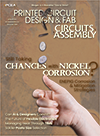Book Reviews
 Author: Edited by Karl Puttliz and Kathleen Stalter
Author: Edited by Karl Puttliz and Kathleen Stalter
Publisher: Marcel Dekker
Publication date: 2004
At least six books relating to lead-free technology are now available, some produced by researchers and some by users. These books provide an ideal first source of information in a structured manner and are in most cases better resources than the Web. Quite a few more will likely hit the streets between now and 2006, including a new title by Jennie Hwang due out this year to complement her previous Electrochemical Publication titles.
In my opinion, this new book from the IBM partnership of Puttlitz and Stalter is the best volume currently available. It contains a good mixture of theory and practical lead-free information that is often overlooked by other lead-free guides.
Although many process engineers may jump directly to the process sections for insight into the firsthand experiences of Panasonic, IBM, Universal and Philips, try to avoid skipping the other great sections. Cherrypickers will miss out on the major issues of lead-free conversion, such as components and wave soldering.
The book includes a good deal of information on wave issues and feedback on possible prevention of fillet lifting, changes to contamination monitoring, new protection for stainless steel erosion and machine design changes - including separation distance between waves, positive cooling after the wave and board support.
Japanese suppliers seem to have made more innovative machine changes based on their practical experience. The redevelopment of the reflow process by companies in Japan is interesting. It is fair to say that their previous reflow technology was not up to date with equipment in Europe and the U.S. With the need for higher temperatures and better controls, Japanese companies have undertaken considerable development to improve delta T capability for lead free.
The Netherlands-based Vitronics Soltec has also gained considerable process experience over the last few years and has effectively presented their data to industry, strengthening their brand name in Europe and the U.S.
Reliability engineers will be happy with the amount of information and the number of good references for more research. The book details lead-free alloys, including their performance, potential reliability and cost implications for the end user.
A well-illustrated section is devoted solely to tin whiskers, describing in detail the potential problems of whisker growth. The authors outline the current thinking and possible solutions to what is still a bewildering phenomenon.
My only criticism of the book is that the alignment of some tables and illustrations does not relate to the text on the page. Otherwise, this textbook is definitely a worthwhile investment; I hope the publisher aggressively markets it to bring it to the attention of more engineers.
Press Releases
- Indium Corporation Technical Expert to Present at SiP Conference China
- Flex Announces Kevin Krumm as Chief Financial Officer
- Green Circuits Enhances Inspection Capabilities with New DAGE Quadra 5 Pro X-ray System
- Western Digital CEO David Goeckeler Elected Chair of Semiconductor Industry Association


